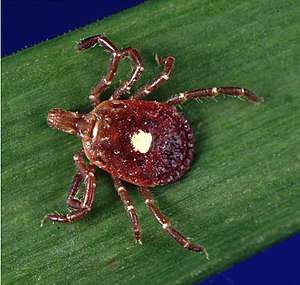Eriophyoidea
Eriophyoidea are a superfamily of herbivorous mites. All post-embryonic instars lack the third and fourth pairs of legs.[1] The respiratory system is also absent.[1]
| Eriophyoidea | |
|---|---|
 | |
| Electron micrograph of Floracarus perrepae attacking a plant | |
| Scientific classification | |
| Kingdom: | |
| Phylum: | |
| Class: | |
| Subclass: | |
| Order: | |
| Superfamily: | Eriophyoidea Nalepa, 1898 |
The taxonomy of this group has always been confused. There were families created for few or even one species, i.e. Ashieldophyidae Mohanasundaram, 1984 and Pentasetacidae Shevchenko, 1991 but these families were placed by J. W. Amrine and T. A. Stasny within larger groups.[1] Today the following three families are believed to belong to superfamily Eriophyoidea:[1]
- Eriophyidae Nalepa, 1898
- Phytoptidae Murray, 1877
- Diptilomiopidae Keifer, 1944
The group is ancient, with forms already similar to the modern ones being found in Triassic amber: Ampezzoa and Triasacarus. These two eriophyioideans are the most ancient arthropods ever found in amber.[2]
References
- Ewert E. Lindquist, M. W. Sabelis & Jan Bruin, ed. (1996). Eriophyoid Mites: their Biology, Natural Enemies, and Control. World Crop Pests. 6. Elsevier. ISBN 978-0-444-88628-6.
- Schmidt, A. R.; Jancke, S.; Lindquist, E. E.; Ragazzi, E.; Roghi, G.; Nascimbene, P. C.; Schmidt, K.; Wappler, T.; Grimaldi, D. A. (2012). "Arthropods in amber from the Triassic Period". Proceedings of the National Academy of Sciences. 109 (37): 14796. doi:10.1073/pnas.1208464109. PMC 3443139. PMID 22927387.
This article is issued from Wikipedia. The text is licensed under Creative Commons - Attribution - Sharealike. Additional terms may apply for the media files.
